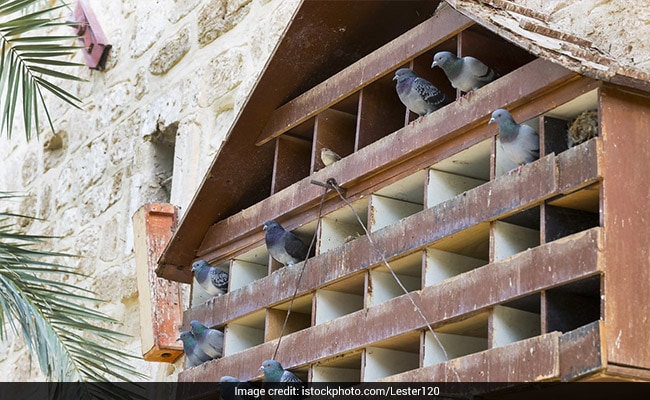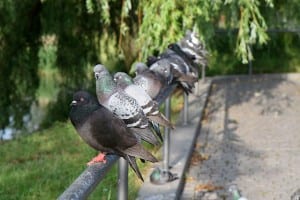
by Pigeon Patrol | Aug 23, 2019 | 4-S Gel Bird repellent, Animal Deterrent Products, Bird Deterrent Products, Bird Netting, Bird Spike, Bird Spikes, Pigeon Control, Pigeon Droppings, Pigeon Patrol's Services, Pigeon Spikes, Pigeons in the News, UltraSonic Bird Control

Pigeon backpacks measure air pollution in London.
Air pollution caused by diesel vehicles in London is bad – so bad that it is blamed for 9,500 premature deaths a year and has prompted Britain’s Supreme Court to order the government to make a plan for cleaning up the skies.
Now what is commonly seen as another scourge of the city, the pigeon, is helping in the fight against smog. On Monday, 10 birds outfitted in miniature backpacks carrying pollution sensors and GPS trackers took to the air, and they started tweeting – via beak, perhaps, but definitely via Twitter – their devices’ readings of nitrogen dioxide and ozone. Londoners who tweet at the Pigeon Air Patrol’s Twitter handle, @PigeonAir, are getting responses from the birds about air pollution in their area, and a live map of the pigeons’ location can be viewed online.
The patrol is, by the admission of the technology and marketing companies that created it, a publicity stunt meant to raise awareness about the city’s harmful air. Birds, it should be noted, are also subject to all sorts of nefarious ailments caused by air pollution, including lung damage and low body weight.
“There’s something about taking what is seen as a flying rat and reversing that into something quite positive,” Pierre Duquesnoy, creative director at marketing agency DigitasLBI and the brains behind the pigeon pollution monitors, told the Guardian.
Plume Labs, the tech firm, gave assurance that a veterinarian was involved in the project to ensure the safety of the pigeons, whose names include Coco, Julius and Norbert.
The London pigeons are not the first birds to don backpacks for an environmental cause.
Vultures in Lima, Peru, have been adorned with GPS trackers and GoPro cameras to hunt down illegal garbage dumping sites.
Have a Pigeon Problem?
Pigeon Patrol Products & Services is the leading manufacturer and distributor of bird deterrent (control) products in Canada. Pigeon Patrol products have solved pest bird problems in industrial, commercial, and residential settings since 2000, by using safe and humane bird deterrents with only bird and animal friendly solutions. At Pigeon Patrol, we manufacture and offer a variety of bird deterrents, ranging from Ultra-flex Bird Spikes with UV protection, Bird Netting, 4-S Gel and the best Ultrasonic and audible sound devices on the market today.
Voted Best Canadian wholesaler for Bird Deterrent products eight years in a row.
Contact us at 1- 877– 4– NO-BIRD, (604) 585-9279, or visit our website at www.pigeonpatrol.ca

by Pigeon Patrol | Aug 22, 2019 | 4-S Gel Bird repellent, Animal Deterrent Products, Bird Deterrent Products, Bird Netting, Bird Spike, Bird Spikes, Pigeon Control, Pigeon Droppings, Pigeon Patrol's Services, Pigeon Spikes, Pigeons in the News, UltraSonic Bird Control

BHUBANESWAR: With the onslaught of social media and e-communication services, pigeongram may have become a thing of the past across the globe, but the Odisha Police continues to keep alive this unique practice.
The service was put to test yesterday when the Odisha Police, in association with the Bhubaneswar chapter of Indian National Trust for Arts and Cultural Heritage (INTACH), flew 50 pigeons at OUAT Grounds here to deliver missives of heritage conservation to Cuttack, 25km away.
The ceremony was attended by people from all walks of life, including schoolchildren from Bhubaneswar and Cuttack.
Former DGP and state convener of INTACH, A B Tripathy, praised the police department for preserving the age-old tradition.
The determination of the men who run India’s only police pigeon service has “guaranteed the survival of a practice” that was prevalent in the Mughal era, he said.
SP (signal) BN Das said Odisha was the only state in India to use carrier pigeons to communicate among police stations.
The Odisha Pigeon Service started in 1946 when 200 pigeons were handed over to police personnel by the army on an experimental basis to communicate in areas with no wireless or telephone links, Das said.
The service was first pioneered in the mountainous Koraput district, and its success and reliability resulted in its introduction to almost all the districts of the state with over 700 sturdy Belgian Homer pigeons ferrying messages to assigned destinations.
For years, these dependable birds have been a vital link between remote police stations, where traditional communications failed, beating storms, disasters – and birds of prey, the SP (signal) said.
The messages, written on a piece of paper, were inserted into plastic capsule and tied to the feet of the Belgian Homer Pigeons, which can fly 25 km in just 15 to 25 minutes and live up to 20 years, he added.
The service, headquartered in Cuttack, was extensively used during floods and Super Cyclone in 1999, as radio networks were disrupted, said a senior police officer, adding that the pigeon service was also the only line of communication to the marooned town of Banki during the disastrous flood in 1982.
Ornithologist Panchami Manoo Ukil feels this practice needs to be preserved for the next generation to get an idea about the ancient traditions.
“Pigeon service is an art that dates back to the Mughal days. The birds delivered messages to the harems and battlefields. This unique tradition has historical significance and should be preserved,” he said.
Anil Dhir, a member of INTACH, said the heritage service has generated a lot of interest among the collector’s community.
“All the pigeons reached Cuttack within an hour,” he added.
Have a Pigeon Problem?
Pigeon Patrol Products & Services is the leading manufacturer and distributor of bird deterrent (control) products in Canada. Pigeon Patrol products have solved pest bird problems in industrial, commercial, and residential settings since 2000, by using safe and humane bird deterrents with only bird and animal friendly solutions. At Pigeon Patrol, we manufacture and offer a variety of bird deterrents, ranging from Ultra-flex Bird Spikes with UV protection, Bird Netting, 4-S Gel and the best Ultrasonic and audible sound devices on the market today.
Voted Best Canadian wholesaler for Bird Deterrent products eight years in a row.
Contact us at 1- 877– 4– NO-BIRD, (604) 585-9279, or visit our website at www.pigeonpatrol.ca

by Ryan Ponto | Aug 21, 2016 | Bird Netting
 At first, Sebastopol area resident Nancy Martin and her husband did not know what to make of the frequent booming bird noises they suddenly started hearing in mid-August.
At first, Sebastopol area resident Nancy Martin and her husband did not know what to make of the frequent booming bird noises they suddenly started hearing in mid-August.
Neither did their neighbors.
“We were walking around the neighborhood and we’d run into people, and they’d say, ‘What’s that noise we’re hearing?’ ” Martin said. “And we would say, ‘I don’t know, maybe hunting.’ ”
But the sounds were going off at very frequent intervals — sometimes as much as 20 per minute — and could last for 13 hours a day, Martin estimated. So hunting-related gunshots didn’t sound quite right.
Then a neighbor emailed with the most likely answer: bird cannons. Vineyards employ the noise-making devices powered by propane to scare away birds that may seek to prey on their valuable crop as harvest approaches.
The use of bird cannons is nothing new, particularly in agriculture-heavy Sonoma County, but Martin, who said she has lived in her neighborhood for 30 years, could not recall ever hearing them before.
“Sometimes, it would be back to back: you’d hear ‘boom’ and then another ‘boom’ right away,” Martin said. “My dog seriously was just shaking.”
Concerns expressed by Martin and several other residents in west Sonoma County highlight a familiar tension in agricultural areas: Growers, empowered by the county’s right-to-farm ordinance, are entitled to protect their crops, but local residents sometimes feel farming disruptions interfere with their quality of life.
John Balletto, owner of Balletto Vineyards and Winery in the Russian River Valley, said his vineyard has not used bird cannons this year because it has not felt very dramatic “bird pressure.” But he knows how bad it can get in other years: Balletto recalled one instance some 15 years ago when he had a 2-acre block of pinot grigio “picked clean” by waxwings.
The damage can add up quickly. A typical vineyard in Sonoma County yields about 3 tons of grapes per acre, or a crop valued at about $7,650 per acre at last year’s average price, according to the U.S. Department of Agriculture.
Balletto acknowledged that complaints from neighbors can arise, and he recommended taking an equally neighborly approach to resolving those conflicts.
“If you have a neighbor that has some concerns, just go have a conversation with that person,” Balletto said. “We’re still able to farm and do stuff, but it’s also important to try to have good neighbor relations.”
Cannons are not the only tool vineyards have at their disposal to defend against birds like starlings and waxwings. One popular option is bird netting, which growers can place over their crops to shield them from winged pests, but that can be a costly and labor-intensive route to take. Balletto said his vineyard is using bird alarms, which emit noises of predatory birds, and has found them to be more effective than cannons so far.
Still others employ actual birds of prey — falcons — to scare off hungry flocks.
With Wine Country’s harvest season gearing up, Lisa Correia, Sonoma County’s assistant agricultural commissioner, said last week that her office had yet to receive any complaints about bird cannons. But she said the commissioner’s office generally works closely with residents and businesses to resolve such issues.
“If somebody isn’t using (bird cannons) properly, then we can usually talk to the grower and get them maybe better educated or informed,” Correia said. “That usually helps create less of a chance of a nuisance being created.”
Solano County officials last year passed an ordinance regulating use of noise-making devices such as bird cannons for agricultural purposes. The ordinance spells out a number of requirements for the devices, including that they cannot be used more than 11 times per hour from 30 minutes after sunrise until 30 minutes after sunset.
Additionally, the ordinance allows for no more than one noise-making device for every 5 acres of land with crops needing protection from damage by birds or other wildlife. Devices within 50 feet of the property line need to be relocated at least 200 feet every four days, and they can’t be directed at residences closer than 400 yards away without rotating automatically and erecting a “sound baffle” between the residence and the device.
While Sonoma County does not have such an ordinance for noise-making devices, it does have recommended guidelines for propane cannons. A copy of the guidelines provided by Correia warns cannons “can and will annoy nearby residents and domestic animals,” and that if a field is surrounded by houses or has a “sensitive neighbor,” cannons may not be a wise choice, pointing to netting, falconry and “general harassment” as other options.
The guidelines further note that birds can rapidly adjust to the noise of cannons and recommend ways that growers should position cannons to maximize their effectiveness. The guidelines also say growers can mitigate noise by putting a plywood backstop behind cannons; warn growers not to use them before sunrise or after sunset; and suggest that the location of cannons be changed frequently and the interval between discharges vary.
Correia said the guidelines have been around for many years, in which time complaints about noise devices at harvest time have declined.
“Frankly, they’ve become a little less relevant because we don’t get as many calls these days,” Correia said. “It’s become less of an issue.”
The same may not be true for Napa County this year. Greg Clark, Napa County’s agricultural commissioner, said his office had heard more complaints about bird cannons than in the past few years, but he was not sure why. Clark said his county does not have a specific ordinance or written guidelines about bird cannons.
Clark said Napa, like Sonoma County, generally takes an educational approach to resolving disputes. That may mean, for instance, informing growers their cannons are firing too often.
Clark said he did not want to minimize the impact birds can have on crops, recalling one instance when a grower’s cannon was firing about every 20 seconds.
“While we stood there and talked, he would see the starlings flying around, and this person would say, ‘See the birds?’ ” Clark said. “You could have that thing firing off every second and the birds would still be there. They’ve gotten used to it.”
Still, Clark said some neighbors also may not fully appreciate what it means to move into an agricultural area, where disruptions, to a certain extent, come with the territory.
Balletto made a similar point.
“At the end of the day, there might be times when we disagree on things,” he said. “But if we don’t bring a crop in, nothing’s sustainable.”
About Pigeon Patrol:
Pigeon Patrol Products & Services is the leading manufacturer and distributor of bird deterrent (control) products in Canada. Pigeon Patrol products have solved pest bird problems in industrial, commercial, and residential settings since 2000, by using safe and humane bird deterrents with only bird and animal friendly solutions. At Pigeon Patrol, we manufacture and offer a variety of bird deterrents, ranging from Ultra-flex Bird Spikes with UV protection, Bird Netting, 4-S Gel and the best Ultrasonic and audible sound devices on the market today.
Voted Best Canadian wholesaler for Bird Deterrent products four years in a row.
Contact Info: 1- 877– 4– NO-BIRD (www.pigeonpatrol.ca)
 At first, Sebastopol area resident Nancy Martin and her husband did not know what to make of the frequent booming bird noises they suddenly started hearing in mid-August.
At first, Sebastopol area resident Nancy Martin and her husband did not know what to make of the frequent booming bird noises they suddenly started hearing in mid-August.


